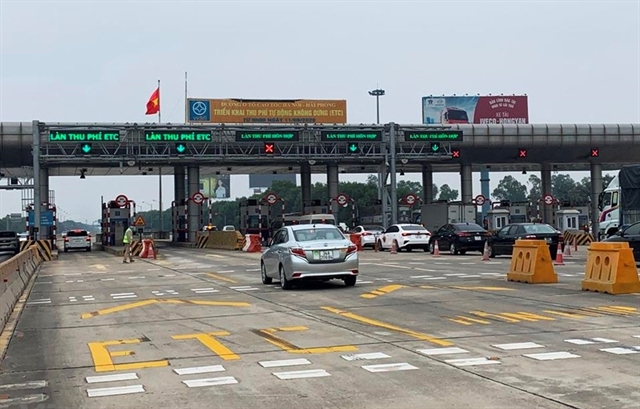 Society
Society

Motorists travelling on the Hà Nội-Hải Phòng Expressway will only be able to pay tolls using electronic means.

|
| A car entering the electronic toll collection (ETC) lane on the Hà Nội - Hải Phòng Expressway. — VNA/VNS Photo Việt Hùng |
HÀ NỘI — Motorists travelling on the Hà Nội-Hải Phòng Expressway will only be able to pay tolls using electronic means.
In a pilot scheme from May 5, vehicles will not be able to pay by cash, but instead must use the automatic electronic toll collection (ETC).
The move aims to reduce congestion on the busy 105-kilometre route, which sees up to 32,000 vehicles per day.
If successful, the model will be rolled out to other highways in the country, especially the country's North-South Expressway.
As the plan prepares for implementation, designated spots have been set up to allow motorists to pull over and have transponders installed.
This will allow easier traffic flow, and money for the tolls will be automatically deducted from the drivers' ETC accounts.
The ETC lane is much more convenient than the manual toll collection (MTC) booths, as the toll fees can be deducted directly from the driver’s account without having to queue for payment, said Phạm Thành Hưng, a seasoned truck driver on the Hà Nội-Hải Phòng route.
“The registration process is quite fast and simple,” said Hưng.
“When the car passes through the toll plaza, the system can recognise the vehicle, open the barrier, and deduct the fee from the account.”
The transponder, however, will not work through a windshield that has a heat-resistant film layer, which is why it has to be installed on the car hood or the headlights.
Hưng added: “The car hood and headlights can easily heat up during transport, and so it was only a matter of time until the tag is damaged and fall off.
“If the tag comes into contact with soap and chemicals during car washes, the device will wear out very quickly. Then it will cost VNĐ120,000 (US$5) to replace the tag.
“The ‘lifespan’ of the transponder is very low at only a few months, and it is costly for the next replacements.”
He also heard many complaints in online groups of car owners who said that the ETC system still encounters transaction errors that did not allow fee payment. It has been a frustration for drivers as they have money in the account but still have to switch to manual toll lanes.
Lương, another driver also said that he has got the ePass (ETC toll tag) installed on his car since mid-July 2020, yet unable to use it due to errors in the system.
After going through multiple steps for support, he was instructed to bring in his car for service during working hours, which proves to be an inconvenience, he said.
Hà Nội - Hải Phòng Expressway sees on average 30,000 to 32,000 vehicles per day, according to Đặng Văn Nghị, deputy head of the division for toll collection management at Hà Nội - Hải Phòng Expressway Operation and Management One Member Company Limited (under the Vietnam Infrastructure Development and Finance Investment Joint Stock Company - VIDIFI).
However, the percentage of vehicles using ETC remains very low at 35 per cent of the total traffic.
Assessing that ETC-only is a step in the right direction, Nghị said adding that VIDIFI encouraged drivers to install the automatic toll tag on their vehicles in order to start the pilot programme in May this year.
He also expressed his concerns about the lack of instructions regarding prioritised vehicles (ambulances, police and military vehicles, among others), and the solutions for multiple vehicles using the same account for business.
Vehicles going at high speed could be a potential risk for accidents and difficulty for traffic management, he said.
Regarding the fine for unregistered cars using ETC lanes, lieutenant colonel Lê Đức Thọ of the Traffic Police Department said now the drivers were only given a warning. The penalty was only applied for intentional cases.
It has been proposed that speed bumps be installed at these lanes to ensure traffic safety.
The Directorate for Roads of Vietnam (DRVN) will also coordinate with the Traffic Police Department to review and complete traffic management and signal system for comprehensive implementation of the pilot programme.
Solutions will also be prepared for any possible situations that may arise.
The DRVN is currently making adjustments to Decree 100 on the eligibility of vehicles entering ETC lanes, which will facilitate the law enforcement process. — VNS




